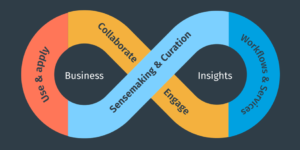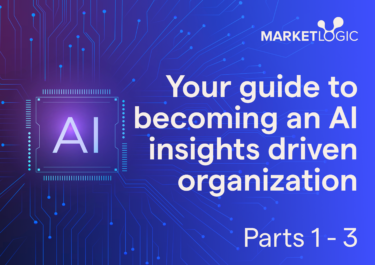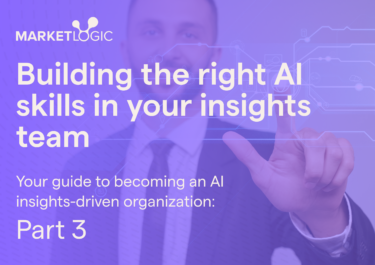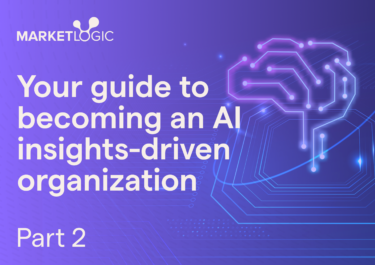
September 9, 2021

September 9, 2021
Did you know you make 35,000 decisions per day? That’s 2000 decisions per hour, assuming you sleep 7 hours a night. In a recent webinar, Market Logic’s Tim Burge talks about what decision-making really is, why it’s so hard for organizations to scale insights for better decision making today, and some real-world examples of companies successfully using this method.
The knowledge doubling curve
Tim started the webinar by talking about the exponential trajectory of human knowledge. In the 1980’s, Buckminster Fuller noticed that by the end of World War II, human knowledge doubled every 25 years. Before that, human knowledge doubled only every century. In 2017, IBM added to the theory and estimated by 2020 human knowledge would double every 12 hours.
Cherry-picked knowledge
You may think having more knowledge available would lead to better, faster decisions, but Tim explained often that’s not true. As the rate of change in knowledge growth increases, it’s compounded by fast changing industries and consumer behavior. In that context, your ability to make decisions actually decreases because you’re overwhelmed by a tsunami of information. The sheer volume of knowledge coming from all the sources available is almost impossible for humans to process. So, Tim pointed out, people have the tendency to cherry pick. For example, your organization’s professionals may choose knowledge that supports their opinion and proves themselves right because they’re too swamped with information. Experts and managers may face decision fatigue and run out of energy to fully consider all data for difficult decisions, inevitably leading to biased, ineffective decisions.
The consequences of poor decision making
The price companies pay for poor decisions is enormous. Harvard Business School estimates that from the 30,000 new products introduced every year, 95% fail. What’s more, IBM estimates businesses lose around $3.1 trillion per year due to poor data for decisions. Tim pointed out that poor insights and data can cost your business reputational damage, missed opportunities, and lost revenue. The question is, how do you make decision-making easier for your organization?
Insights teams need to scale their expertise
The ratio of insights professionals to stakeholders is a massive challenge for organizations in the age of exponential knowledge growth. Tim said if you’re a branded house, for example, you’re likely to have only one expert for every 10 stakeholders who need that expert to help them make insights-driven decisions. If you’re a house of brands, the ratio can be even higher, sometimes as high as one expert for every 100 stakeholders. If your organization wants to drive growth with effective, insights-driven decisions, insights teams need to scale their expertise to meet the organization’s growing knowledge and demand from stakeholders, Tim said.
From content-oriented to process-oriented insights management
Tim shared an overview of how technology has evolved to address the challenges of knowledge and insights management. This isn’t a new challenge, Tim reminded us, and over the years the technology has evolved from content-oriented insights management to process-oriented insights management. First generation technology was about collecting all an organization’s knowledge in one place to build a repository—think SharePoint, Google Drive, and other forms of cloud technology. But these kinds of solutions are limited, Tim said, because they tend to create information silos within organizations. In other words, the information is theoretically somewhere, but it’s hard to find if you don’t know where to look. Second generation technology tries to solve this problem with search engine capabilities. But Tim pointed out that giving people easy access to search doesn’t solve the problem of people becoming overwhelmed by the volume of information and potentially misinterpreting it. What’s needed in addition to repositories and search capabilities is knowledge curation and collaboration capabilities. In this sense, insights teams can support and engage with a very, very large number of stakeholders, but with a formal way of managing that process at scale. That’s where third-generation technology comes in.
The journey from insights to decisions: real-world examples

The following four parts of the insights-to-decisions journey is key to third-generation insights platform technology like Market Logic’s:
“It’s only really by bringing the four parts of the insights journey together that we can really make use of that knowledge repository effectively and get to the stage where we can keep up with the rate of change in human knowledge and the market. Then we can make properly informed decisions based on the knowledge we have without being overwhelmed,” Tim said.
Tim finished the webinar with real-world examples of how organizations around the world are using Market Logic technology to drive growth with insights-driven decisions at scale. A €75B retailer in Europe, for example, used their insights platform to use and apply all of their expert information and opinions to decide whether to enter a new market for instant delivery. A $7B European technology company used their platform to help break down silos between different insights teams for better collaboration. And a $40B pharma company in the US used their insights platform to optimize and automate their research workflows within the heavily regulated health industry, saving huge costs in increased efficiency.

How is AI transforming roles, skills and capabilities in insights functions?

Interview with Nextatlas CEO Luca Morena

An introduction to gen AI for businesses. From RAG to LLMs — get the lowdown.

Exploring the Future of AI in Marketing: Integrating Insights into Business Systems for Enhanced Decision-Making.

To succeed in today's dynamic consumer landscape, your organization must be able to react faster…

How does this guide help you? In part 3 of our guide, we’ll delve into…

Learn the AI insights-powered enterprise systems architecture and processes.

Transform your organization with insights. Download this guide to find out how.